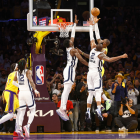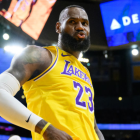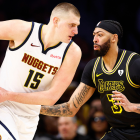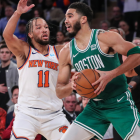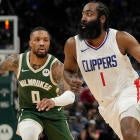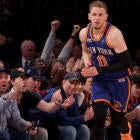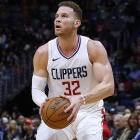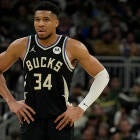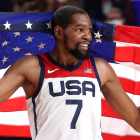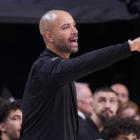
LeBron James looked decidedly un-LeBron James-like as a scorer for the first 47 minutes and 53 seconds of Monday's Game 4 between the Los Angeles Lakers and Memphis Grizzlies. After taking 26 shots in the restricted area through the first three games of the series, he managed to get there only five times to that point in the fourth. Prior to the final possession of regulation, he had attempted only four shots in the quarter, and he had missed all of them.
Two weeks of trash-talk finally looked like they were about to pay off for the Grizzlies. They'd held James to 5-of-15 shooting, taken away his best looks and were on the verge of tying their first-round series with the Lakers at two games apiece, heading home for the pivotal Game 5.
Except that's not what wound up happening. With 6.7 seconds to go, the Lakers drew up a sideline play for James, who raced past Xavier Tillman to bank in a game-tying layup with just under one second left in regulation. The Lakers went on to win the game in overtime, and with it a commanding 3-1 series lead.
This is all pretty standard James fare, right? Well, not exactly. The play itself hinged on two moments. The first was a critical decision by the Grizzlies. The second was a stroke of genius by James. So let's go through the final offensive play of regulation for the Lakers and figure out how James managed to finish one of the biggest layups he's made in the purple and gold.
The key moment on the Memphis end of the equation came before the ball was even inbounded. Dennis Schroder served as the inbounds passer, but the real action was on the far side of the court. The play itself was relatively simple, designed strictly to get James the ball at the top of the arc so he could make a decision. But the way the Lakers aligned themselves suggests that they were expecting a different matchup.
Austin Reaves is behind the 3-point line on the ring wing. James, on the other hand, is a bit deeper than the right elbow. James-irritant Dillon Brooks is defending Reaves. The bigger Xavier Tillman is lined up on James. When play begins, James motions as if he's going to set a screen for Reaves, who flares into the right corner. James never makes contact, and instead runs towards Schroder to accept the pass.
Here's where things get interesting. Many teams adopt a strict "switch everything" approach to these late-game situations. The idea is to ensure that nobody gets an open look at a jump shot even if it means sacrificing a mismatch elsewhere on the floor. The Grizzlies, having surely scouted the Lakers' SLOB (sideline out-of-bounds) approach thoroughly before the series, knew that the Lakers have an end-of-game play designed specifically to create a corner 3. They famously used it to win their first game of the season. Remember Matt Ryan?
The Lakers were aligned pretty similarly on this play, though the deficit was two, not three. As James sets the soft screen, Rui Hachimura moves to set a screen for him. The design here was likely to force the Grizzlies into a triple-switch that would have resulted in Desmond Bane guarding James. That was a matchup that the Grizzlies were never going to allow, but a more preemptive switch on that early movement from Reaves could have gotten Brooks onto James even if he would have needed to chase James through Hachimura's screen -- a manageable task, especially since James would have been settling for a low-percentage 3-pointer if he was desperate for a quick look. Instead, the Grizzlies chose not to switch anyone at all. Brooks stuck with Reaves when he and James swapped places, so when James darted to the top of the key, it was Tillman who followed him.
There are two elements of this decision that merit debate. The "switch everything" approach is designed to stymie jumpers in situations where jumpers are all that are likely to be available. With one or two seconds left on the clock, ball-handlers simply don't have time to create layups. With 15 seconds left on the clock, matchups are prioritized. But 6.7 seconds? That's a bit of a grey area. A ball-handler can make a play if he acts quickly enough. And obviously, James did.
Here's the more interesting question: which defender should Memphis have preferred to trail James between Brooks and Tillman? Brooks has been the primary defender on James in this series. He is among the best perimeter defenders in the NBA. Yet the numbers clearly favor Tillman in this series, specifically. Through three games, James shot 14 of 23 from the floor with Brooks as his primary defender and only 7 of 17 against Tillman. James struggled against Tillman in Game 4 as well. He frequently found Tillman switched onto him following screens only to settle for jumpers or pass the ball out to a teamamte.
The ultimate decision here is a matter of priority. Brooks is smaller and a bit quicker. He'd have an easier time staying in front of James driving downhill, but that sacrifice in size meant that James would have an easier time shooting over Brooks if he did wind up settling for a jumper. Tillman is only one inch taller, but has a seven-foot wingspan. Brooks has a wingspan of only 6-6. If James had simply dribbled out the clock and fired up a possible game-winning 3, Tillman would have bothered James more by getting a hand in his face. On a drive, however, James would have a slightly easier time getting past him.
James ultimately did so, albeit by just a hair. This was an eventuality Memphis was prepared for. Jaren Jackson Jr. was the best rim-protector in the NBA this season, so once he was certain that James couldn't dump the ball off to Davis in the dunker's spot, he launched himself up at the ball. Were James any other ball-handler, Jackson might have rotated a split-second earlier. But he had to account for Davis. That gave James just enough airspace to get the layup off cleanly. Of course, no layup is truly "clean" in the Defensive Player of the Year's presence. A typical layup gets swatted away and the game ends then and there. This is where 20 years of experience truly paid off for James and the Lakers.
Take a look at where the ball is when it hits the backboard. Knowing that Jackson is capable of blocking the ball at almost any other angle, James somehow manages to arc the ball off the absolute top of the backboard using only his fingertips without sacrificing any accuracy. The ball just barely squeaks past the outstretched hand of Jackson and banks in for the tie.
This is a combination of reflexes, dexterity and basketball IQ that few players in basketball have ever had. It requires absolutely perfect timing, and James nailed it. After struggling to get to the basket for an entire game, James pulled this gem out of his bag of tricks to save the day, and as he explained after the game, it is not only a play he practices specifically for defenders like Jackson, but it is one he's used against similar rivals.
"I work on different layup packages," James explained. "Tier 1 is a layup that's really just right underneath the rim where you lay it off the glass. Tier 2 is like the middle of the glass or the middle of the square. Tier 3 is over the top of the square. Shot out to [trainer] Chris Johnson. We work on those depending on the shot-blocker. I've had moments where I've been able to scoop those high layups. One that comes to mind is, I don't remember which Finals it was, but in Golden State I was able to drive right, keep the ball in my right hand, and underhand scoop it over KD."
It's an encouraging sign for a Laker team that has struggled to generate half-court offense throughout this entire series. James, dealing with the ravages of both age and a foot injury that will likely require eventual foot surgery, can't be his old self for whole games anymore. Right now, it isn't even clear if he can get there for an entire quarter. But on Monday, the Lakers got confirmation that James can still summon his old self when they need it most. Stealing the win was important. But that bit of knowledge was absolutely essential if this team is going to have any chance at winning the championship.













